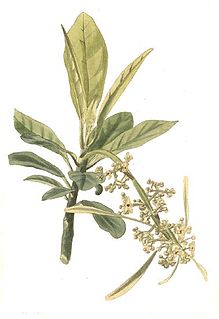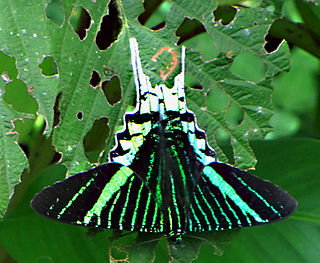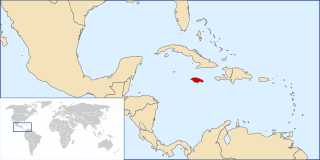
Urania was, in Greek mythology, the muse of astronomy, and in later times, of Christian poetry.

Omphalea is a plant genus of the family Euphorbiaceae first described as a genus in 1759. It is native to tropical parts of the Americas, the West Indies, Asia, Australia, and Africa.

Tragia is a genus of flowering plants in the spurge family, Euphorbiaceae. It is widespread across North and South America, Africa, the Arabian Peninsula, the Indian Subcontinent, northern Australia, and to various islands in the Caribbean and in the Indian Ocean.

Chrysiridia rhipheus, the Madagascan sunset moth, is a species of day-flying moth of the family Uraniidae. It is considered one of the most impressive and appealing-looking lepidopterans. Famous worldwide, it is featured in most coffee table books on Lepidoptera and is much sought after by collectors, though many older sources misspell the species name as "ripheus". It is very colourful, though the iridescent parts of the wings do not have pigment; rather the colours originate from optical interference. Adults have a wingspan of 7–9 cm (2.8–3.5 in).

Themeda triandra is a perennial tussock-forminggrass widespread in Africa, Australia, Asia and the Pacific. In Australia it is commonly known as kangaroo grass and in East Africa and South Africa it is known as red grass and red oat grass or as rooigras in Afrikaans. Kangaroo grass was formerly thought to be one of two species, and was named Themeda australis.

The Uraniinae or uraniine moths are a subfamily of moths in the family Uraniidae. It contains seven genera that occur in the tropics of the world.
Wallichia triandra is a species of flowering plant in the family Arecaceae that is native to South Tibet in China and also to the neighboring Arunachal Pradesh region of India.
Horsfieldia triandra is a species of plant in the family Myristicaceae. It is a tree endemic to Sumatra.

Oxygyne triandra is a species of plant in the Burmanniaceae family. It is endemic to Cameroon. Its natural habitat is subtropical or tropical dry forests. It is threatened by habitat loss.

Urania sloanus, or Sloane's urania, was a species of moth of the family Uraniidae endemic to Jamaica. It was last reported in 1894 or 1895, but possibly survived until at least 1908. The species was first described by Pieter Cramer in 1779.

Salix triandra, with the common names almond willow or almond-leaved willow, is a species of willow native to Europe and Western and Central Asia. It is found from south-eastern England east to Lake Baikal, and south to Spain and the Mediterranean east to the Caucasus, and the Alborz Mountains. It usually grows in riparian habitats, on river and stream banks, and in wetlands.

Phocides is a primarily Neotropical genus of butterflies in the skipper family, Hesperiidae (Eudaminae). A few species occur in the Nearctic.

Urania leilus, the green-banded urania, is a day-flying moth of the family Uraniidae. Although many credit Carl Linnaeus with first describing the species in his 1758 10th edition of Systema Naturae, Maria Sibylla Merian described the butterfly in her book Metamorphosis Insectorum Surinamensium, which was published in 1705. It is found in tropical South America east of the Andes, including Suriname, French Guiana, eastern Colombia, Venezuela, eastern Ecuador, Brazil, northern Bolivia, eastern Peru, and Trinidad. It has been recorded as a vagrant to the central and northern Lesser Antilles such as St. Kitts, Barbados and Dominica. The habitat consists of riverbanks in primary and secondary rainforest at elevations between sea level and about 800 m (2,600 ft).
Omphalea ankaranensis is a plant species endemic to a small region in northern Madagascar. Type locale is in Antsiranana Province, inside Réserve Speciale Ankarana, 7 km SE of Matsaborimanga. Plant grows on limestone soils.

Urania is a genus of moths in the family Uraniidae.

Urania boisduvalii is a day-flying moth of the family Uraniidae. It was first described by Félix Édouard Guérin-Méneville in 1829. A genetic analysis of Urania moths gave rise to a phylogenetic tree which places U. boisduvalii as sister to the in-group that includes U. fulgens spp. poeyi, U. fulgens, U. sloanus, U. sloanus, U. leilus and U. leilus spp. brasiliensis.
Urania poeyi is a day-flying moth of the family Uraniidae.

Omphalea celata is a rare plant species found in Queensland, Australia.
Elatine triandra is a species of flowering plant belonging to the family Elatinaceae.














